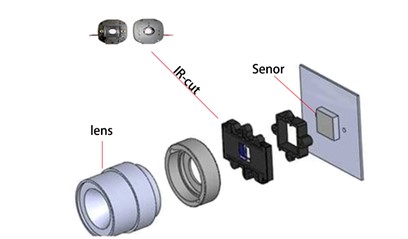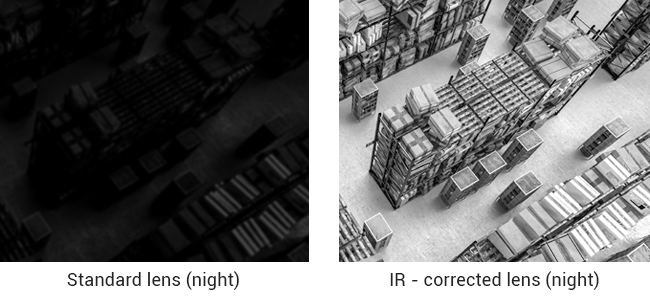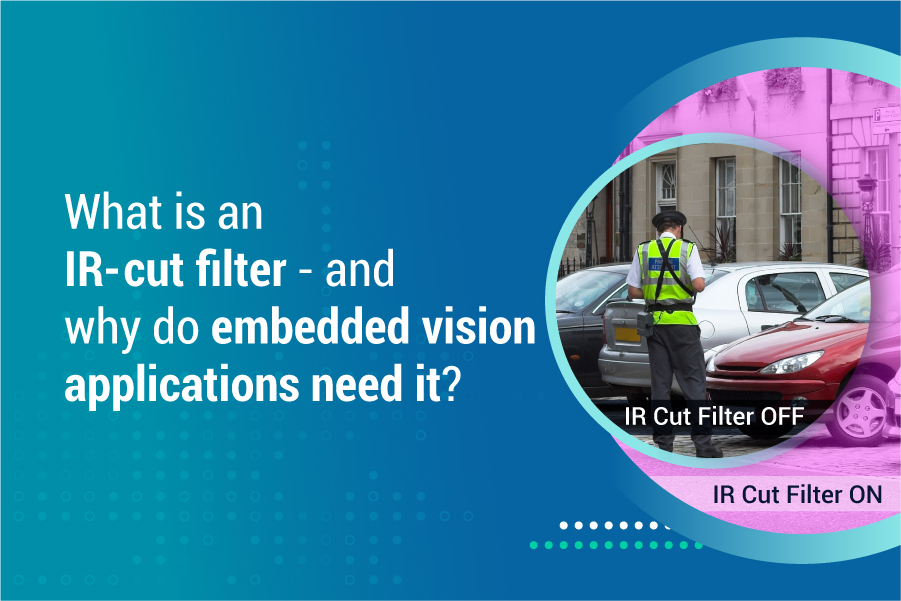In recent years, day/night video surveillance has expanded beyond the traditional practice of monitoring only critical infrastructure. Generally, systems such as CMOS cameras and CCD cameras capture accurate images in daylight. Their sensors can detect near-infrared light that is invisible to the human eye. While this can be an important feature for night-vision recording –the infrared light distorts the colors of recorded images during daytime hours.
Before deeply discussing the IR-cut filter, let’s take a quick look at what “infrared” means.
What is Infrared?
Infrared (IR) is also known as radiant energy. It is electromagnetic radiation that has longer wavelengths than visible light. Normally, human eyes can view light with a wavelength ranging between 320nm – 760nm. The IR ranges between 700nm to 1000nm on the electromagnetic spectrum.
It is far more than what a human eye can view – as only NIR cameras can capture images in this wavelength range.
What is an IR-cut filter?
IR-cut filter is a mechanical shutter design that blocks or delivers the IR – providing a high-quality image with true color reproduction – irrespective of day or night.
Unlike human eyes, camera sensors can detect near IR light outside the range of the visible spectrum. To make the image more similar to what humans can view, most OEM cameras are fitted with an IR-cut filter which allows only the visible light to pass through – thereby reflecting the unwanted IR.
Below are sample images with and without an IR-cut filter:

How does an IR-cut filter work?
Generally, an IR-cut filter is placed between the image sensors and the lens as shown below.

This filter is controlled by a motor or with the help of an electromagnet. When the IR filter is turned on during the daytime, it helps to block IR – letting only the visible light pass through. This process is known as True Day Night (TDN) because it delivers true color images during the day and black and white or night vision images at night. It ensures that the image colors are not disturbed and generates a true representation of colors – as seen naturally by the human eye.
When the IR filter is turned off during the night or in low-light conditions, it helps IR and other forms of light to reach the CCD/CMOS sensor. The image sensor, in turn, absorbs enough light – and the camera turns to black-and-white mode, which is more sensitive to IR light.
An IR-cut filter can be used in devices with bright incandescent light bulbs to prevent unwanted heating.
If you are interested in learning more about NIR imaging, please have a look at the article What is NIR imaging and how do NIR cameras work?
Now, let us discuss in detail the advantages of using an IR-cut filter.
Three reasons to use an IR-cut filter
- To avoid color distortion – Generally, IR light leads to color distortion during the day. To solve this issue, an IR-cut filter is used to keep the IR light disturbance out of the image sensor during the day. When the light falls below a certain level, the filter automatically swivels out of the way so that the IR light does hit the image sensor. Also, the camera switches to black-and-white mode to use the IR light optimally.
- To achieve realistic colors – The IR-cut filter in a color camera can achieve realistic colors in white light. In general, the color spectrum viewed by the human eye is quite limited compared to the spectrum viewed by a CCD camera. Especially, the difference in sensitivity is significant in the near IR region of the spectrum. If an IR-cut filter is not used, a huge amount of infrared light will appear – resulting in strange colors.
- To achieve color correction in lenses – In many cases, it is difficult to design imaging optics covering both the visible spectrum and the near IR spectrum. Therefore, many lenses have different depths of focus for the visible and the IR spectrum. In such cases, the IR-cut filter cuts away a significant amount of the collected light and achieves color correction in lenses. Please have a look at the below image to understand the difference between a standard lens output and a color corrected lens output:

Embedded vision applications that rely on IR-cut Filter
Some of the embedded vision applications where an IR-cut filter is used are discussed below:
Video Conferencing
In a video conferencing camera, the lenses should ensure high image quality and a large field of view (FOV) while maintaining a very low distortion at the same time. So, an IR-cut filter helps to produce accurate color images with color CCD or CMOS cameras. The filter blocks the transmission of IR light while passing visible light. It can be performed by absorption or reflection optical techniques. The absorptive filters are made with special optical glass to absorb the near IR radiation. In comparison, the reflection type filters are short-pass interference filters that reflect IR light with high efficiency.
Automatic Number Plate Recognition (ANPR)
An ANPR system is expected to accurately recognize a vehicle’s plate number based on an image captured by an ANPR camera. It can be performed through the combination of steps, such as capturing the real image, locating and identifying individual characters on the plate, and recognizing the optical character. During the nighttime, a color camera with an IR-cut filter can capture clear images. Therefore, it helps identify the individual symbol image on the plate, the number of characters on the license plate, and the text luminance level (dark text on a light background or light text on a dark background).
To learn how to do number plate recognition using e-con’s global shutter camera and Raspberry Pi4, please have a look at the article Automatic number plate recognition using e-con Systems’ global shutter camera and Raspberry Pi4.
Smart Surveillance System
Nowadays, most of the CCTV cameras are equipped with IR illumination. The IR-cut filter is placed in front of the cameras with a night vision sensor. The human eye can’t notice the IR illumination light, but the camera sensor can view it perfectly. In monochrome mode, if the picture quality is good, the IR radiation has a major effect on the image in the daytime. Also, smart surveillance cameras with night vision are equipped with an IR cut filter to protect against rays, thus achieving an accurate image.
NIR cameras from e-con Systems
With more than 20 years of experience in the camera technology space, e-con Systems has developed a wide portfolio of NIR cameras. PFB the comprehensive list of NIR cameras from e-con Systems.
- See3CAM_CU135M – 4K Monochrome USB 3.1 Gen 1 Camera
- Sony® Pregius IMX264 Monochrome USB Camera
- See3CAM_CU55M – 5MP Monochrome USB NIR Camera
- See3CAM_CU27 – Sony® Starvis™ IMX462 Ultra Low Light USB 3.1 Gen 1 Camera
- See3CAM_20CUG – 2MP OV2311 Monochrome Global Shutter Camera
- See3CAM_27CUG – 2MP OV2312 RGB-IR Global Shutter Camera
- See3CAM_CU30 – 3.4 MP Low Light USB Camera
- Conversa® – Low Light USB Camera with Microphone
Hope this piece of content threw some light into how an IR-cut filter works. If you have any further queries on the topic, please leave a comment. We shall get back to you as soon as possible.
If you are interested in integrating embedded cameras into your products, kindly write to us at camerasolutions@e-consystems.com. You could also visit our Camera Selector to get a complete view of e-con Systems’ camera portfolio.

Prabu is the Chief Technology Officer and Head of Camera Products at e-con Systems, and comes with a rich experience of more than 15 years in the embedded vision space. He brings to the table a deep knowledge in USB cameras, embedded vision cameras, vision algorithms and FPGAs. He has built 50+ camera solutions spanning various domains such as medical, industrial, agriculture, retail, biometrics, and more. He also comes with expertise in device driver development and BSP development. Currently, Prabu’s focus is to build smart camera solutions that power new age AI based applications.




